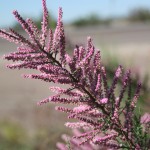Saltcedar, Tamarisk
Tamarix spp.
Tamaricaceae (Tamarisk family)
Description
A native of Europe and Asia, saltcedar was introduced in the United States as an ornamental in the early 1800s. As its name implies, saltcedar can tolerate extreme salinity.
Most saltcedars are deciduous shrubs or small trees typically growing 10 to 30 feet tall and forming dense thickets. A few species are evergreen. The plant has slender branches and dense, gray-green foliage. The young twigs and stems have smooth, reddish brown bark.
The leaves are very small and scalelike, about 1/16 inch long. They often have a crustlike scale from salt secretions. From March to September, the plant produces small white, pink or purple flowers in dense masses on its stem tips. It can produce up to 500,000 seeds per plant each year from April through October.
Saltcedar has fair forage value for goats and deer.
Habitat
Saltcedar grows in moist soils near rivers, streams and lakes or in shallow groundwater tables.
Images
Plant Characteristics
Flower Color: Pink, White
Seed Type: Fruit/Berry
Duration: Perennial
Stem Texture: Hairless/Smooth
Growth Habit: Shrub (Woody)
Leaf Shape
 : Simple with Pinnate or Parallel Venation
: Simple with Pinnate or Parallel Venation
Season: Warm
Distribution
 : 02 - Gulf Prairies and Marshes, 05 - Cross Timbers and Prairies, 06 - South Texas Plains, 07 - Edwards Plateau, 08 - Rolling Plains, 09 - High Plains, 10 - Trans-Pecos
: 02 - Gulf Prairies and Marshes, 05 - Cross Timbers and Prairies, 06 - South Texas Plains, 07 - Edwards Plateau, 08 - Rolling Plains, 09 - High Plains, 10 - Trans-Pecos
Distributions
Distribution refers to the ecological region in Texas that a plant has been found. You can also view a clickable map.
Book: Brush and Weeds of Texas Rangelands (B-6208)
Collection: Brush and Weeds









